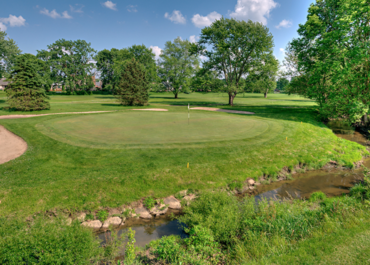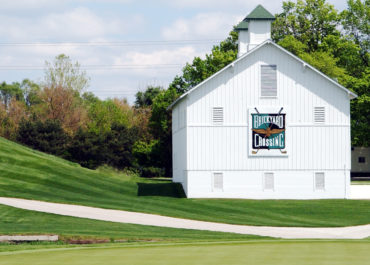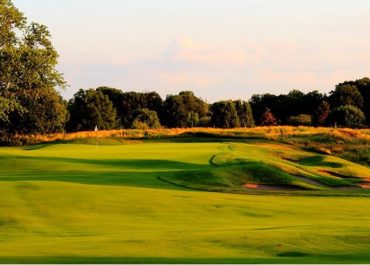
There are 15 golf courses in Indiana “built” by the late, great golf-course architect Pete Dye, the most of any state in America.
That’s understandable considering Dye lived in Indiana for about 60 years and resided in a home on his creation at Crooked Stick Golf Club in Carmel, a leafy northern suburb of Indianapolis, until his final years.
Dye’s importance to golf in the Hoosier State and overall influence on the game naturally spawned the Pete Dye Golf Trail, a seven-course collection with some of the master architect’s favorite public layouts in Indiana.
We have all learned that Pete rarely made any course design decisions without first running them by his wife Alice, who was equally brilliant and innovative in her approach to how their courses looked and, ultimately, played for all levels of golfers.
There have been changes to the Dye Golf Trail’s original lineup through the years – with some courses removed and others added – but the current assemblage is still vital and important as a primer for the Dyes’ growth as architects and helps cement their places in the pantheon of course designers.
Three of the Dye Golf Trail’s courses are in the Indianapolis area and all are critical pieces to Dye’s maturation as a designer and his ability to both optimize a chunk of real estate. This trio courses should be included in a textbook of golf course design, not because any of them are among Dye’s best but because each has its place in the progression in his thoughts about course design 50 years ago and how those ideas were changed and adapted for different projects and what Pete and Alice were ultimately trying to produce.










Maple Creek Golf & Country Club
Maple Creek was Dye’s first design at Heather Hills Country Club on Indianapolis’ northeast side in 1961, Maple Creek Golf and Country Club was the first 18-hole course built (he says he never “designed” a course) by Dye and represents the first chapter in the story of his illustrious career. Created in partnership with Alice, Maple Creek’s intense routing begins with small tee boxes and often-diminutive greens complexes and putting surfaces. The routing rolls down hilly terrain through fairways narrowed by mature trees, and is accentuated by areas of tall native grasses. Selective bunkering adds to the test, as does a creek that winds through the first 10 holes and is prominent on four of them.
Carded at just 6,593 from the back set of four tees, the par-72 course at Maple Creek carries a rating of 72.7 and slope of 141, showing you that the Dyes meant business from the start. These degrees of difficulty come mostly from the course’s absolute demand for accuracy. Sheer length isn’t an issue here, as just three of the par-4s (the 456-yard 11th, 401-yard 14th and 410-yard 17th) extend more than 400 yards.
Three of the first four holes are wonderful short par-4s, all playing 347 yards or less, with the yardage not hinting at their testiness. Other front-nine highlights are its two par-5s. The sixth plays 540 yards, with water right and the fairway lined by tall trees on both sides. It ends at a green just 29 yards deep, but the approach is made to an area where the putting surface is half that width. Meanwhile the 535-yard ninth turns hard leftward on the approach, giving the hole the look of a question mark.
The home half is a bit wider but also home to Maple Creek’s longest par-4s. The top hole might be the 475-yard, par-5 13th, which has two bunkers along the right of the prime landing area and two others closer to the green, which — at 47 yards across — is the biggest on the course. The round ends at a 185-yard par-3 that plays uphill to a huge putting surface ringed by three bunkers. I wonder how many other Dye-designed courses end with a one-shotter (not many I’d wager).
There are none of Dye’s later signature railroad ties or large waste bunkers at Maple Creek, but it’s easy to see his stamp on the course, especially in the placement of water hazards and movement on the greens. Any aficionado of Dye’s work should play Maple Creek and step back 60 years to see where one of the game’s greatest architects placed his first imprint.






Brickyard Crossing Golf Club
You’ve likely seen several of the holes at Dye’s creation at Brickyard Crossing Golf Club in Speedway when you’ve watched the iconic Indianapolis 500 through the years. Golfers are keen to pay a little more attention to the overhead shots of the action of the race, especially those who have played the unique and ultra-challenging course that borders — and even enters — the massive Indianapolis Motor Speedway along the edifice’s backstretch.
Because four of Brickyard Crossing’s 18 holes are set within the infield of the huge oval, the course is surely distinctive for its setting. But, thanks to Dye’s handiwork, there’s a whole lot more to like about this course than its location. It’s one of the testiest courses in America, one that demands your best, especially on its home stretch. Brickyard Crossing has a history almost as storied as the Speedway itself. Bill Diddel designed the original course on the site in 1929, when green fees for the 27-hole layout were 75 cents on weekdays and a whopping $1 weekends. Golfers crossed a wooden bridge over the brick-paved speedway to play nine of the holes in the infield on what was considered the first automobile racetrack golf course in the nation.
Eventually, more of the infield was needed for the track’s infrastructure so, in 1991, Dye was hired to oversee the remodel. The project took two years and involved demolishing the old course and changing it from 27 holes (18 outside, nine in the infield) to the current 18-hole Brickyard Crossing, a nod to the racetrack’s nickname.
Brickyard Crossing is a par-72 and 7,180 yards from its back set of four tees. The tips carry a rating of 75.1 and Slope of 149, difficulty created by gently rolling terrain, a creek that enters play on eight holes and a handful of forced carries.
Dye placed a lot of the characteristics here for which he is known: waste bunkers and railroad ties, steep drop-offs behind putting surfaces, an abundance of tall native grasses off fairways in which to lose a ball or two, and even an occasional stand of trees. Along the way Dye spiced the routing with both pot and conventional-style bunkers; these hazards are quite tame early on but become more complex as the round progresses.
More than 1.5 million cubic yards of earth were sculpted to provide the dramatic terrain for Brickyard Crossing. For the most part, there are ample landing areas off tees, but golfers must be able to work the ball in both directions and be spot-on to find these demanding greens. The most talked-about section of the course is the sequence of holes seven through 10 in the infield. From the sixth green, golfers move through a tunnel that goes under the racing surface to the interior of the racetrack. From the elevated tee on the 181-yard par-3, Redan-style seventh, golfers can see the track clearly and watch — or hear — as drivers get ready for the big race; practice laps take place year-round.
The 464-yard, par-4 eighth is likely the toughest hole at Brickyard Crossing, with water running along the entire left side. The green is guarded by two bunkers at the right, making length and precision paramount. Once back outside the track, the grandstand for Turn 3 looms over the 11th, 12th and 13th holes. Brickyard Crossing then moves away from the Speedway and into another testy stretch. It’s here where the course has the majority of its real elevation changes.
The 491-yard par-4 closer offers one final body blow, playing across the creek to the fairway and then back up to a green that may be the wildest on the course. Behind the putting surface is a barn that predates Brickyard Crossing, the original course and the Speedway itself, and was once part of the dairy farm that occupied the property before car racing – or a Dye-designed golf course – became part of its history. Brickyard Crossing allows golfers a vantage point most players never even considered – a round in the shadow of, and within, one of the world’s greatest sporting venues, one that attracts 300,000 fans every Memorial Day Sunday for the Indy 500.
Golfers might be first attracted to Brickyard Crossing because of that setting. But most leave thinking just how tough the round was and how they would love to get another chance to prove themselves. That sounds a lot like the sentiment most race-car drivers carry while trying to win the Indy 500, making the course a fitting companion to the vaunted Speedway.






The Fort Golf Course
Usually just having Dye’s name as the designer of a golf course assures its success, multiple accolades and a full tee sheet. But when a course is built on a piece of land as lush and prime for the role as the one that became The Fort Golf Course in the near-northern city limits of Indianapolis, it likely wouldn’t matter whose name is attached to it.
The Fort GC which encompasses 238 acres of rolling hills and tree-lined corridors on the site of the former Fort Benjamin Harrison Military Reservation, bears the Dye stamp. But it relies on what Mother Nature bestowed on the property as much as the handiwork of arguably the greatest living golf course architect.
In 1996, the U.S. Department of the Interior approved the state of Indiana’s request to convert 1,700 acres of the 2,500-acre shuttered post into a state park and nature preserve. Dye and collaborator, Tim Liddy, revamped an old course at the site and created a championship par-72 layout that plays at 7,148 yards from its back set of four tees. From its tips, The Fort GC, which boasts all-Bentgrass tees, fairways and greens, has a rating of 75.0 and 143 Slope.
Here you will find Dye’s trademark wavy greens and a nice balance of short and long par-4s as well as a quartet of some of the most demanding par-3s (including the 247-yard 17th) anywhere.
“There are changes in the topography out there that make you doubt you are in Indianapolis, even though the course is right on the edge of town,” Dye once said of the property. “The forests that line the fairways are all native hardwoods, and a stream that runs through the course makes the player think he’s in a different world. And everything out there is natural.”
Dye and Liddy had a mission to make the course more playable and easier to walk without too much interruption of the endemic terrain. The resulting layout is beautiful and a bit tricky, sporting deep ravines at one turn and wide fairways bordered by mature trees at others. There’s also a great mix of green complexes, some of which are protected by steep bunkers and grassy swales and others with open fronts that allow bump-and-run shots.
Elevation changes create the need for assured club selection, with many tees raised and several greens significantly higher than fairways. Success here comes from the ability to recognize the slope of the terrain and find the level landing zones. The Fort alternates between birdie opportunities and places where you’re happy with par. It takes a lot of skill — and mettle — to tackle the aforementioned 247-yard 17th. And the 474-yard closer has one of the few severe doglegs on the course, with the green protected by a large, narrow bunker at the right.
There are no residences along the course and there never will be as the property is surrounded by preserved land, all of which is owned and operated by the Indiana State Park system.
The Fort Golf Course is considered one of Indiana’s top public facilities. All levels of players will appreciate the variety in the design and the serenity of this unspoiled golf environment.












Other Dye Golf Trail courses are great, too
The four other courses on the Dye Golf Trail are every bit as great, challenging and vital as the three we’ve profiled here.
Dye helped revamp both of the courses at Purdue University in West Lafayette. Today the Kampen Course and the Ackerman-Allen Course make up one of the best 36-hole collegiate facilities in the nation as part of the Birck Boilermaker Complex.
The newest addition to the Dye Trail is Tippecanoe Country Club in Monticello, set on the banks of Lake Shafer about 40 miles north of West Lafayette. After many facelifts and expansions, Tippecanoe CC caught Dye’s attention in 1963. As one of his first projects, he designed the back-nine and added lush greenery and tees to the original course.
You have also likely heard about Dye’s course at the fabulous French Lick Resort — it’s set in the turn-back-the clock destination in southern Indiana on some of the state’s highest ground and is a must-play when in the region.

